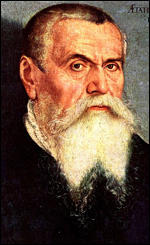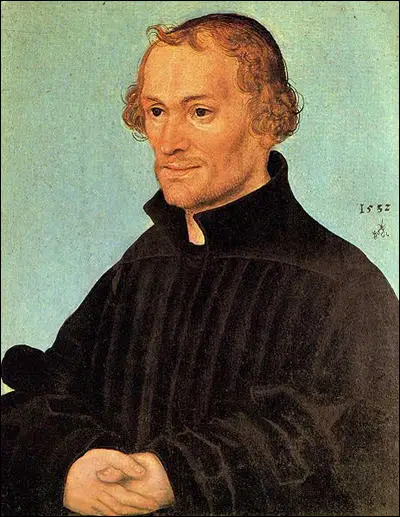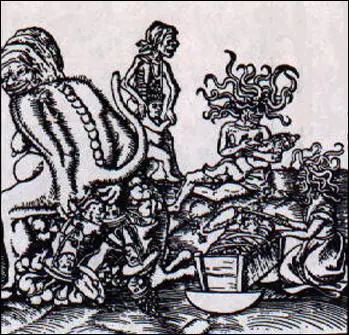Lucas Cranach the Elder

Lucas Cranach, the Elder (original name Lucas Müller), the son of Hans Müller, was born at Kronach in about 1472. It is not known where he trained but he was working with his father from 1495 to 1498. He moved to Vienna and in about 1502 adopted the name Cranach. In 1505 he was appointed as court painter to Frederick III of Saxony. His reputation was so good that he was given two and a half times the salary paid to his predecessor. (1)
Cranach moved to Wittenberg, a university town on the Elbe River. For the next forty-five years he presided over an army of assistants in his large and busy workshop. (2) He also had close connections to the newly founded University of Wittenberg. This included being friends with leading Protestant reformers such as Martin Luther and Philipp Melanchthon.
As Friedrich Thöne has pointed out: "Cranach painted portraits of Luther, his wife, Katherina von Bora, and his parents. Through these and other portraits, he helped form today's image of Luther's circle. Indeed, apart from his other duties as court artist, Cranach became the chief pictorial propagandist of the Protestant cause in Germany, multiplying the images of the Reformers and the Protestant princes in innumerable painted, engraved, and woodcut portraits... Cranach also did altarpieces and paintings for Lutheran churches." (3)
In 1512 Lucas Cranach married Barbara Brengebier. Over the next few years she had several children including Hans, Lucas the Younger, Ursula, Barbara and Anna. During this period he became extremely wealthy and one of the city's most respected citizens, serving as a member of the town council in 1519–20 and as burgomaster three times. Cranach achievements resulted in many young artists settling in Wittenberg and the town became an art centre. "His paintings were eagerly sought by collectors, and his busy studio often produced numerous replicas of popular designs, particularly those in which he showed his skill at depicting female beauty." (4)

Lucas Cranach was considered in his youth to be an avant-garde artist of considerable emotional force. Notable among them are a Crucifixion (1500), St. Jerome in Penitence (1502) and the St. Catherine Altarpiece (1506). However, critics have argued that his Cranach’s style was fully formed and underwent little development after about 1515. It is generally believed that his portraits do not reach the high standard of Hans Holbein. (5)
The German Bible
Owen Chadwick, the author of The Reformation (1964) has pointed out the Cranach worked closely with Martin Luther: "He (Martin Luther) began to translate the New Testament into German. He had determined that the Bible should be brought to the homes of the common people. He echoed the cry of Erasmus that the ploughman ought to be able to recite the Scripture while he was ploughing, or the weaver as he hummed to the music of his shuttle. He took a little more than a year to translate the New Testament and have it revised by his young friend and colleague Philip Melanchthon... The simplicity, the directness, the freshness, the perseverance of Luther's character appeared in the translation, as in everything else that he wrote". (6)
The translation of the Bible into German was published in a six-part edition in 1534. Also involved in the project was Philipp Melanchthon, Johannes Bugenhagen, Caspar Creuziger and Matthäus Aurogallus on the project. There were 117 original woodcuts included in the 1534 edition issued by the Hans Lufft press in Wittenberg. This included the work of Lucas Cranach.
Derek Wilson, the author of Out of the Storm: The Life and Legacy of Martin Luther (2007) has argued: "With the New Testament Luther staked a place at the very forefront of the development of German literature. His style was vigorous, colourful and direct. Anyone reading it could almost hear the author proclaiming the sacred text and that was no fortuitous accident; Luther's written language was akin to the oral delivery of his own impassioned sermons. His translation was couched in compelling prose." (7)

Luther commissioned Lucas Cranach to make woodcuts in support of the Reformation, among them "The Birth and Origin of the Pope" (one of the series entitled The True Depiction of the Papacy, which depicts Satan excreting the Pontiff). He also commissioned Cranach to provide cartoon illustrations for his German translation of the New Testament, which became a best seller, a major event in the history of the Reformation. (8)
Despite his allegiance to the Protestant cause, he continued to work for Catholic patrons and was a very astute businessman. He remained in Wittenberg until 1550 when he followed John Frederick into exile, in Augsburg. (9)
Lucas Cranach the Elder died on 16th October 1553.
Primary Sources
(1) Friedrich Thöne, Lucas Cranach the Elder : Encyclopædia Britannica (2014)
The Protestant Reformation had begun in 1517 in Wittenberg with Martin Luther’s Ninety-five Theses. Cranach was on friendly terms with Luther, who had been a teacher at the University of Wittenberg since 1508. Cranach painted portraits of Luther, his wife, Katherina von Bora, and his parents. Through these and other portraits, he helped form today’s image of Luther’s circle. Indeed, apart from his other duties as court artist, Cranach became the chief pictorial propagandist of the Protestant cause in Germany, multiplying the images of the Reformers and the Protestant princes in innumerable painted, engraved, and woodcut portraits. The scope of this activity is indicated by a single payment in the electoral accounts (1533) for “sixty pairs of small paintings of the late Electors.” Cranach also did altarpieces and paintings for Lutheran churches. His works were sought after by Protestant and Roman Catholic patrons alike, and hundreds of pictures now in museums and private collections testify to his exceptional productivity. Aside from his paintings, there are more than 100 separate woodcuts by him.
(2) Victor S. Navasky, The Art of Controversy (2012)
Hans Holbein... created a woodcut depicting Martin Luther as "the German Hercules," in which Luther beats scholastics as Aristotle and St. Thomas Aquinas into submission with a nail-studded club.
Luther commissioned such artists as Lucas Cranach the elder to make woodcuts in support of the Reformation, among them "The Birth and Origin of the Pope" (one of the series entitled The True Depiction of the Papacy, which depicts Satan excreting the Pontiff). He also commissioned Cranach to provide cartoon illustrations for his German translation of the New Testament, which became a best seller, a major event in the history of the Reformation.
Student Activities
Henry VIII (Answer Commentary)
Henry VII: A Wise or Wicked Ruler? (Answer Commentary)
Henry VIII: Catherine of Aragon or Anne Boleyn?
Was Henry VIII's son, Henry FitzRoy, murdered?
Hans Holbein and Henry VIII (Answer Commentary)
The Marriage of Prince Arthur and Catherine of Aragon (Answer Commentary)
Henry VIII and Anne of Cleves (Answer Commentary)
Was Queen Catherine Howard guilty of treason? (Answer Commentary)
Anne Boleyn - Religious Reformer (Answer Commentary)
Did Anne Boleyn have six fingers on her right hand? A Study in Catholic Propaganda (Answer Commentary)
Why were women hostile to Henry VIII's marriage to Anne Boleyn? (Answer Commentary)
Catherine Parr and Women's Rights (Answer Commentary)
Martin Luther and Thomas Müntzer (Answer Commentary)
Martin Luther and Hitler's Anti-Semitism (Answer Commentary)
Martin Luther and the Reformation (Answer Commentary)
Mary Tudor and Heretics (Answer Commentary)
Joan Bocher - Anabaptist (Answer Commentary)
Anne Askew – Burnt at the Stake (Answer Commentary)
Elizabeth Barton and Henry VIII (Answer Commentary)
Execution of Margaret Cheyney (Answer Commentary)
Robert Aske (Answer Commentary)
Dissolution of the Monasteries (Answer Commentary)
Pilgrimage of Grace (Answer Commentary)
Poverty in Tudor England (Answer Commentary)
Why did Queen Elizabeth not get married? (Answer Commentary)
Francis Walsingham - Codes & Codebreaking (Answer Commentary)
Sir Thomas More: Saint or Sinner? (Answer Commentary)
Hans Holbein's Art and Religious Propaganda (Answer Commentary)
1517 May Day Riots: How do historians know what happened? (Answer Commentary)
